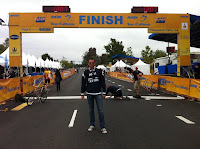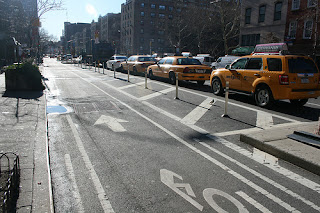I get several articles sent my way every week from other advocates and colleagues at work. I received an interesting article this past weekend that Nick Martens wrote in 2008 "
The Problem of Biking in America," published in the online magazine
The Bygone Bureau.
"Of the many complaints an American cyclist can make, a concern over his or her safety is the most serious. It is also the best reason to stick with a car."
In the article, Martens describes the common problem of a motorist unexpectedly opening a car door in the path of a cyclist properly staying in the bike lane on the right side of the street. Without question, fear of bike-auto collisions is among the most pervasive factors limiting bike use for U.S. commuting trips. In the United States, the driver-side door opens into the bike lane; in European streets designed for bikes it does not.
I have found that many factors seem to limit urban biking in the United States. For those older than 25, fear of losing in an encounter with a speeding car is probably the most important reason, with adverse weather being another. Relatively few of those who bike to work do so every day; bad weather requires a backup plan. Lack of convenient bike storage is common in city apartments, and there is a justifiable fear of theft. Commuting in America for so long has meant single-occupancy cars that the mindset is doubtlessly hard to break. Americans have grown accustomed to the $8,000 annual cost of auto ownership (including depreciation), so saving money by cycling is a less pressing concern. Plus, American streets have been designed and refined to facilitate automobile traffic at speeds of 30 miles per hour or more—and are less safe for bike traffic.
Freedom from Fear
In the Netherlands, the degree to which the safety of bikers is protected varies with development density. Outside city limits, some roads are marked for bike lanes, but many have no indication of where biking is encouraged. In cities, however, the Dutch have invested heavily in dedicated bike lanes with special safety controls—essentially a separate set of red, yellow, and green lights for cyclists. The most elaborate arrangement of roadways includes areas designated for four different means of transit. Those designations are:
-
the center lane, for cars, trucks, trams, and buses.
-
the next lane, for auto parking; the driver’s door does not open toward bikers.
-
the bike lane.
-
the lane next to the buildings, for pedestrians: the sidewalk.
The ability to make streets multimodal and widely used by bike commuters depends on the degree to which the dedicated lanes are made reassuring to potential users. To produce comfortable conditions for bikers requires clarity: what are the rules? how should bikers and drivers behave? what is our turf and what is theirs? Ambiguity breeds uncertainty, which in turn contributes to accidents and discourages potential bikers. Where European bicycle traffic is greatest, investments in clarity are most apparent. Clarity factors include separate, protected lanes; traffic signals dedicated to cyclists; and obvious signs signaling where bikes may go and where they should not.
The broad popularity of biking in dense European cities at peak periods has resulted from the infrastructure investments that produce a comfort level almost unimaginable in the United States. Gray-haired women pedal to go shopping; parents move their preschool children by bike through downtown traffic. On a scale of one to ten evaluating biker concern about possible injuries, conditions witnessed in northern Europe would generally rate an eight or nine, while U.S. cities would rate a two.
Prospects for American Conversion
Those who advocate planning for expanded U.S. use of bikes frequently cite improved health or expanded recreation, mixing these desirable goals with the most salient of the European gains, those related to bikes as urban transportation. Occasional recreational use will not contribute significantly to cleaner air, less-congested streets, or wider use of public transit.
Martens noted the political impasse associated with encouraging public investment in bike- friendly U.S. cities when there is so little daily biking occurring—a condition in large measure attributable to the lack of bike-friendly conditions. American bikers are predominantly young, male, and urban—not a powerful constituency. Most Americans are car owners, happy with that condition, and sometimes antagonistic to bikers.
Any jurisdiction contemplating a serious modification of streets to reduce fear of cyclist injuries and expand use of bikes for commuting and shopping should study the results in Copenhagen. Important options have already been tested there. Starting with specified goals would help planners avoid some expensive missteps. Copenhagen, for example, seeks to increase the share of bikers who feel comfortable or secure when biking to 80 percent, and is well along toward that goal.
The shift from cars to bikes in Europe can be traced to the steady, persistent, decades-long pace followed by governments there in adapting streets to create bike-friendly transportation routes. A cheap effort will not do it. An inexpensive stripe next to a parking lane does not produce comfortable biking conditions; in many cases it is a recipe for collisions with car doors. It is hard to imagine U.S. cities committing to two or three decades of block-by-block reconstruction and continued bike-oriented education and rule enforcement. Opposition could be expected to proposals to move car parking toward the center of the street and install special traffic controls and curbs designed to protect bikers.
Also, there are stronger competitors for America’s infrastructure funding. The highway lobby has a 50-year lock on gasoline tax revenues. Other claimants—subways, buses, and commuter rail—may receive a larger share of these funds as the country tries to cut petroleum dependency. There is also the newly recognized need to repair and upgrade thousands of bridges and tunnels that elected officials pray will not collapse on their watch.
Probably the best prospects for financing conversions would follow use of appropriations for a larger public cause, such as reducing global warming or employing jobless workers. Two or three good examples in American cities might influence others. New York City is modifying some streets to favor biking. Philadelphia might create a bike connection linking the convention center, seven museums, and the Schuylkill River trail, connecting Drexel and Pennsylvania universities with existing bikeways reaching Norristown and beyond—more a recreational than a transportation benefit, but it would produce substantially more people on two wheels than at present. Broad Street and Market Street may be wide enough for bike lane protection, with some loss of curb and delivery parking. Requiring bike storage facilities in new residential buildings and fewer car parking spaces would help. A gasoline price of $10 per gallon would boost bike use, but do little for the comfort level in peak-hour traffic.
In a nation attuned to quick and cheap solutions, the widespread replacement of cars by bikes as accomplished in European cities will be seen as a long-range and expensive objective.













